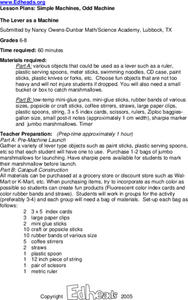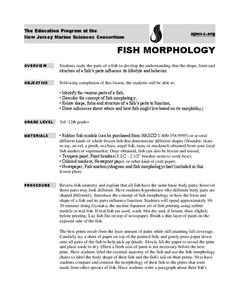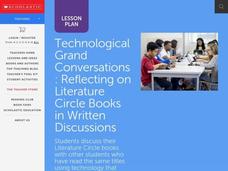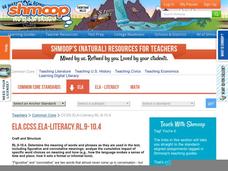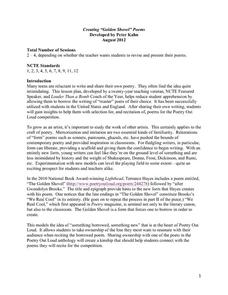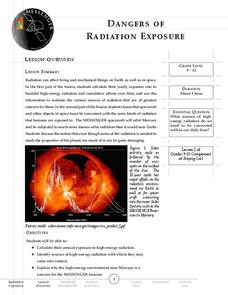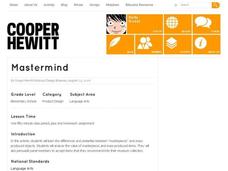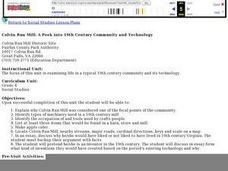Curated OER
Potato Fish Adaptations
Learners examine fish adaptations. They identify types of adaptations, and create a 3-D model of an imaginary fish that demonstrates various adaptations using a potato and craft materials.
Curated OER
Simple Machines, Odd Machine
Students construct a device to 'launch' a marshmallow at the teacher and then discuss various forms of levers. They work in teams to design catapults and identify different kinds of levers.
Curated OER
Trash To Treasure
In this environmental worksheet, students learn about reusing trash and making crafts and useful items instead of throwing it into a landfill. Students study 15 pictures of crafts and list as many trash items as they can find.
Curated OER
LA CENERENTOLA (Cinderella)
Students formulate how to make puppets and realize that puppetry, like opera, is another kind of theater. They gain deeper knowledge of the characters in Rossini's La Referentially. Students use this concept to make decisions about...
Curated OER
Paper Clay Fish Sculpture
Why not get creative and use paper clay to create colorful fish sculptures? All the steps needed to complete this activity are included. Your class will sculpt beautiful fish while exploring color, shape, and creative thinking. Use these...
Curated OER
Kids Can Help
In this helping worksheet, students read about ways they can help pets affected by Hurricane Katrina. These include raising money to support the HSUS Disaster Relief Fund, by holding a car wash, bake sale, or auction.
SeaWorld
Bird Biology
Here you will find two good activities designed for young learners. In the first one, pupils explore the fact that all birds have feathers, and they discover what two uses those feathers have. After the discussion, the kids color in a...
Consortium for Ocean Science Exploration and Engagement (COSEE)
Fish Morphology
Life comes in all different shapes and sizes, and fish are no exception. Here, young scientists create fish prints as they learn how specific characteristics allow different species to survive in their particular habitats.
Curated OER
AZTEC TILES
Pupils observe the shapes and lines that make up Aztec sculpture, study Pre-Columbian art as they discover the Aztecs, Mayans and Incas. They create a small-scale Aztec tile using pasta. Creative, clever and engaging.
Curated OER
The Life Cycle of a Butterfly
A well-designed lesson on the life cycle of the butterfly is here for you. In it, young scientists spend 45 minutes a day, for one school week, engaged in their study. They take nature walks, participate in activities in centers, listen...
Curated OER
Technological Grand Conversations
Conduct a written literary discussion and diminish stress about public writing. Class members, already arranged into literature circles, compose and post responses to novels, signing with initials or class number. The process continues...
Shmoop
ELA.CCSS.ELA-Literacy.RL.9-10.4
The fourth standard for reading literature in the Common Core calls for young readers to be able to determine the figurative and connotative meanings of words and phrases. Use this resource, a continuation of a series of Common Core...
Poetry Out Loud
Creating "Golden Shovel" Poems
Get even your most reluctant pupils reading, writing, reciting, and maybe even enjoying poetry! A four day lesson, young writers learn about Golden Shovel poems: a poem format that uses borrowed words from other poems as the last words...
Curated OER
Turtle and Tortoise Preschool Lesson Plan
One of the best parts about teaching the littlest learners is that you can create thematic lessons that use one topic to address every subject. Here is a nice set of thematic teaching ideas that uses turtles and tortoises to teach...
Curated OER
Acid Rain
Create a simulation of acid rain in your classroom with lemon juice and bean plants to help kids study the effects of pollution on plants. In addition, learners will listen to a story and write responses based on guiding questions.
Messenger Education
Dangers of Radiation Exposure
Gamma radiation, which is harmful, is useful in treating cancers. In the second lesson in a series of four, young scientists take surveys and calculate their yearly exposure to ionizing radiation. Then they read about how harmful their...
The New York Times
I Don’t Think So: Writing Effective Counterarguments
When it comes to writing effective arguments, writers must do more than simply make a claim, counterarguments must be considered. Aspiring writers analyze counterarguments in editorials, and then learn how to write counterarguments in...
Curated OER
Garden Tag
Learners create mini "gardens" in recycled clothing boxes. They recycle old seed and flower catalogs and "plant" cut-out flowers in their gardens.
Curated OER
Dragonfly Sculptures
Art projects are great when they apply to other subjects. First study insects, their parts, and their habitats. Then have little ones create a dragonfly. They use clothes pins, raffia, pipe-cleaners, and paint to construct their...
Curated OER
Mastermind
Students observe the differences and similarities between "masterpieces" and mass-produced objects. They analyze the value of masterpieces and mass-produced items. Students persuade panel members to accept items that they recommend into...
Curated OER
Spray Bottle Paint Mural
Sometimes all you need is a quick and easy outdoor art project. Perfect for the end of the school year, this mural project allows kids to make a mess while creating art. They use spray bottles full of paint to "spray" paint a large sheet...
Curated OER
Radial Balance Geometric Shapes
Fifth graders create a radially balanced design using geometric shapes which exhibits their prior knowledge of symmetry. They use a kaleidoscope image to develop a design using markers or colored pencils.
Curated OER
Heads Up
To celebrate cultural diversity and multicultural awareness, learners explore the nature of headwear used around the world. They brainstorm the types of headwear they've seen, and then discuss why people wear coverings on their heads....
Curated OER
Colvin Run Mill: A Peek into 19th Century Community and Technology
Fourth graders take a field trip to a mill, identify the parts of a mill, what was produced there, and what types of occupations were associated with a mill. They write an essay detailing the reasons they would or wouldn't like to have...



